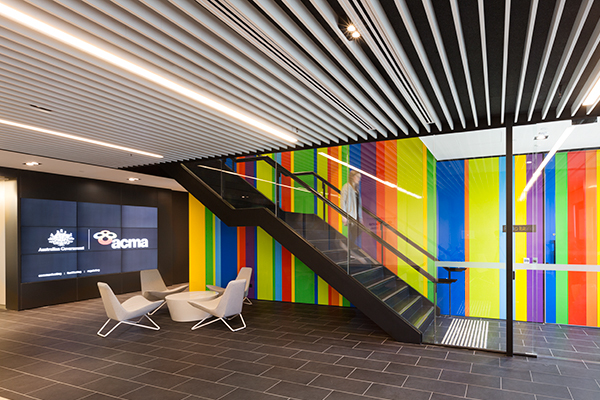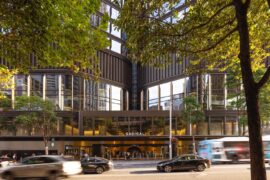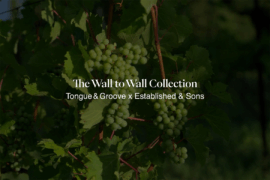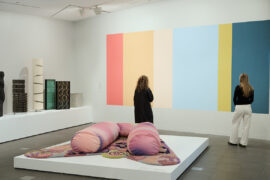The Intention of the Australian Communication and Media Authority’s (ACMA) new Melbourne headquarters, designed by peckvonhartel, is to bring ACMA personnel in to a new work environment that emphasises the ACMA brand and values. Accordingly the tenancy design uses a clever integration of branded elements into the new tenancy. Alice Blackwood reports.

April 4th, 2014
Wayfinding, orientation, collaborative working spaces and greater connectivity were just some of the issues addressed by peckvonhartel in the redesign of the Australian Communication and Media Authority (ACMA) headquarters (HQ) in Melbourne.
Located within an office tower on Elizabeth Street in Melbourne’s CBD, ACMA downsized from 3 floors to 2, engaging peckvonhartel to solve a number of key challenges using clever workplace design and graphic solutions.
The original floorplate (which is diamond-like in orientation), while boasting fabulous views, proved to be extremely disorientating for staff, who could never quite get their bearing once they had entered the tenancy.
“When you are in this office tower which is offset at 90 degrees to Melbourne’s Hoddle grid it is disorientating as to where you are in the building, especially as it’s a central core building,” said project spokesperson and senior design architect with peckvonhartel, Joshua McAlister.
A re-organisation of space saw senior executives’ offices moved to the centre of the building “effectively allowing most people to have a window seat,” said McAlister.
“It was a positive result, allowing the workforce to all have natural light, and fantastic views,” he said.
Collaborative spaces which double as break-out and meeting areas are located at all four points of the diamond floorplate and thereby assist as orientation devices, these collaborative spaces are named after the landmarks (such as Docklands and Dandenongs) which lie in the direct sight-line of each facade.
Among peckvonhartel’s other design objectives was a need for greater connectivity between departments and the reinforcement of ACMA’s brand identity to the public and ACMA staff.
The increased visibility across the diamond floorplate was integral to providing visual connectivity, while the addition of an inter-tenancy stair creates an instant connection between the sweeping entrance foyer and the upper-level offices.
The stair itself is a major focal point, derived from the ACMA brand identity and features a multi-coloured ‘convergence spine’ which straddles the double-height tenancy void. The rainbow colours displayed prominently on the interconnecting stair wall directly references the ACMA brand, bringing it to life through structure and space.
“The ACMA brand symbolises the ‘ever increasing concept of convergence’,” explained McAlister. Here the peckvonhartel interiors team explored imagery and ideas around convergence to conceive a design that would communicate the ACMA brand to staff and external visitors.
“We had a great opportunity with the inter-tenancy stair which, with its double height volume, which became the focal point to anchor the whole design.”
To maximise this brand impact and allow the rainbow hues to be powerful, peckvonhartel also “pulled back” the rest of the palette to muted greys and whites.
The rainbow colours continue to reappear around the remainder of the fit-out, integrated wherever possible into the tenancy structure, rather than be applied as an afterthought or superficial finish.
As a whole, the project “provided ACMA’s team with new spaces that they’d never had before,” said McAlister. The collaborative work spaces, and ability to easily identify with ACMA’s ethos and brand values being the most important benefit of all.
peckvonhartel
pvh.com.au
INDESIGN is on instagram
Follow @indesignlive
A searchable and comprehensive guide for specifying leading products and their suppliers
Keep up to date with the latest and greatest from our industry BFF's!
The new range features slabs with warm, earthy palettes that lend a sense of organic luxury to every space.

Rising above the new Sydney Metro Gadigal Station on Pitt Street, Investa’s Parkline Place is redefining the office property aesthetic.

London-based design duo Raw Edges have joined forces with Established & Sons and Tongue & Groove to introduce Wall to Wall – a hand-stained, “living collection” that transforms parquet flooring into a canvas of colour, pattern, and possibility.

CONCLAD is a bespoke new material revolutionising the use of concrete in architecture and interior design

Snarkitecture, have created yet another designer spectacle, this time for Milanese fashion house, Valextra’s 80th anniversary.

The future of work is here – and it’s arrived packaged up in SLAB Architecture’s winning submission to Herman Miller’s recent design contest. Here, the visionary studio tells us why research and incidental interactions play such an important part in the future of work.
The internet never sleeps! Here's the stuff you might have missed

At the NGV’s Making Good: Redesigning the Everyday, design becomes a force for repair. From algae-based vinyl to mycelium earplugs, the exhibition proves that rethinking the ordinary can reshape our collective future.

Central Station by Woods Bagot in collaboration with John McAslan + Partners has been named one of two joint winners of The Building category at the INDE.Awards 2025. Recognised alongside BVN’s Sirius Redevelopment, the project redefines Sydney’s historic transport hub through a transformative design that connects heritage with the demands of a modern, growing city.